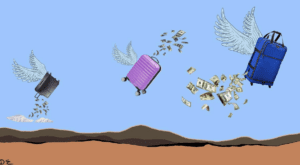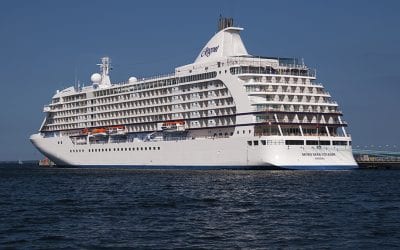Watch out for the hard-to-detect carry-on luggage trap

Illustration by Dustin Elliott
The ticket agent looked at me as if I was hiding something when I checked in for a recent flight from Nicosia, Cyprus, to Tel Aviv, Israel.
“Show me your bags,” she commanded.
I rolled my regulation-size carry-on across the tiled floor so she could see it.
“On the scale!”
Nine kilos. She shook her head slowly. “You will have to check it.”
The agent jabbed a finger toward a lonely cashier at the edge of the terminal, where I would pay $50 to have my regulation-size carry-on flown in the cargo hold for 45 minutes.
I had become the latest victim of the airline industry’s biggest moneymaking scheme of 2023. It’s a trend that we’re just now beginning to understand fully.
Airline luggage fees are rising
In a recent report called Baggage Belts Deliver Cash for Smart Airlines, airline fee consultants IdeaWorksCompany enthusiastically identified fees for carry-on bags as the next big thing in the airline industry. The report called the extras the “king” of airline fees and praised discount airlines like Allegiant and Spirit for leading the industry to a $20.9 billion windfall in 2021.
No question, baggage fees will be big in 2023. Really big. But the problem isn’t just how much airlines are collecting, but what they aren’t collecting.
I had a front-row seat to the carry-on luggage trap
But when I returned from the cashier’s desk, my mood darkened. I saw a young Israeli family returning from their vacation. Each child had a carry-on bag. Two of the three kids were crying and mom looked like she was about to burst into tears. The same gate agent was weighing and sizing every one of the family’s bags.
They would pay dearly for choosing to fly TUS that day.
When airlines and their advocates talk about baggage belts “delivering cash,” here are the people who are paying. It’s families with young kids, elderly passengers, folks with disabilities — in other words, the most vulnerable in our society who often need to carry a lot of stuff.
The other side of the carry-on luggage trap
There’s another side to the carry-on luggage trap. It’s how airlines treat lost luggage. Reader Julio Stieffel shared his story with me this week. He’d checked his bag on ITA Airways (the successor to Alitalia — remember them?). The airline also insisted he check his wheeled bag, but when he did, the airline broke one of his wheels.
Stieffel continued with his trip, checking the bag in a second time on the return flight. “The luggage handlers broke the second wheel,” he says.
He tried to file a damage claim at the airport. But the line was so long that he decided to fill out the paperwork when he got home. When he tried, he discovered that ITA doesn’t have an online claim form for damaged luggage. After some back and forth, ITA told him it wouldn’t fix his bag because he had missed his deadline to file a claim. (And besides, protruding items like wheels aren’t covered.)
Now granted, Stieffel’s case is an extreme example of negligence, incompetence and bureaucracy. But it is noteworthy that in an era of baggage belts delivering cash, airlines still treat us as if luggage were “free.” They want our money but not any of the responsibility that goes with it.
How to avoid the carry-on luggage trap
It used to be easy to avoid the luggage fee grab. All you had to do was avoid “low-fare” airlines like the three black sheep of the U.S. airline industry — Allegiant, Frontier, and Spirit.
But no more.
Experts say small airlines are prodding the legacy carriers that used to have more reasonable luggage policies to start collecting fees any way they can. And that means you could fall into the luggage trap on your next flight.
Find out the carry-on size before you fly
What size is carry-on luggage size? In the U.S., it’s 22 x 14 x 9 inches. It can be as small as 21 x 14 x 8 inches in Europe. But the real “gotcha” is weight. A European gate agent could force you to check your bag if it weighs more than 17 pounds. Be sure you understand the rules and that you’re coming in under size and weight.
Know the shortcut
Always bring a reusable grocery bag to carry the extra stuff on the plane if you need to repack. Gate agents and flight attendants still look the other way when you have a bag of snacks or groceries (particularly for a long flight) or a discreet black backpack. They’re trained to go for the easy targets — those XL bags.
Pack nothing
Coming after our luggage like this is the worst idea since smoking was allowed on planes. By forcing luggage fees on the passengers who can least afford them, they are further stoking the flying public’s wrath.
If the airline industry ever comes back to the American public, hat in hand, asking for another multibillion-dollar bailout, they might be out of luck.
Have you fallen in the luggage trap?

About the art
For this piece, artist Dustin Elliott went “full Dali.” The flying luggage evokes memories of old computer screen savers and the endless frustration of having to give your airline more money for something that should be included in your ticket price.
READ ALSO:
5 airport security mistakes that could delay you, make you miss your flight, or worse
COVID-19 trip cancellations continue — but sickness waivers are ending

Christopher Elliott is an author, consumer advocate, and journalist. He founded Elliott Advocacy, a nonprofit organization that helps solve consumer problems. He publishes Elliott Confidential, a travel newsletter, and the Elliott Report, a news site about customer service. If you need help with a consumer problem, you can reach him here or email him at [email protected].




